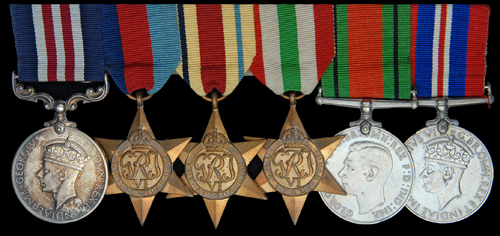
Auction: 8010 - Orders, Decorations, Medals & Militaria
Lot: 124
A Fine Second World War ´Immediate´ ´Final Assault on Cassino´ M.M. Group of Six to Sergeant N. Quarendon, Royal Fusiliers, Who Was a Member of a Small Operation Party of Riflemen and Sappers Who Managed to Effect the Crossing of the River Gari for the 10th and 28th Brigades, He Twice Crossed the River Under Heavy Fire in Order to Relay Information to His Commanding Officer and Evacuate the Wounded a) Military Medal, G.VI.R. (6457282 Sjt. N. Quarendon. R. Fus.) b) 1939-1945 Star c) Africa Star d) Italy Star e) Defence and War Medals, nearly extremely fine, together with the named card case of issue for the M.M., dated 26.10.1944, and the following documents &c.: - Buckingham Palace named enclosure slip for the M.M. - Army Form named to the recipient giving details of a Military Medal Gratuity of £20-0-0 - Army Council enclosure for the Campaign Stars and Medals - Letter to the recipient from the Dunkirk Veterans Association, giving details of the Commemorative Medal, with addressed envelope post-dated 10.5.1976 - The Royal Fusiliers, History of the 2nd Battalion, in North Africa, Italy, and Greece, March 1943-May 1945, in which the recipient is mentioned (lot) Estimate £ 1,200-1,400 M.M. London Gazette 26.10.1944 6457282 Sjt. N. Quarendon, Royal Fusiliers. The Recommendation states: ´´On the night of 11/12 May 1944, two Troops of the 38th Anti-Tank Battery, together with a specialist party of the 2nd Bn Royal Fusiliers were charged with the construction of rafts across the river Rapido [sic] for the crossing of the 10 Inf. Bde. At about 0400hrs on 12 May the crossing site "F2" (ref map Cassino 1/25,000 160 II NE-871179) came under very heavy mortar and machine-gun fire and many casualties were inflicted upon the construction parties. The specialist party, of which Sgt. Quarendon was a member, became split. In the absence of his Officer Sgt. Quarendon immediately rallied the remnants of the party and with untiring energy devoted himself to the evacuation of the wounded across the R. Gari by raft and other means. Although continually under fire from enemy snipers, M.G.s and Mortars, he showed complete fearlessness and never once wavered from his task until the bridge had been erected across the river more than 24hrs later. His personal courage, cheerfulness and infectious energy was most inspiring to all who saw him.´´ 6457282 Sergeant Norman Quarendon, M.M., served during the Second World War with the 2nd Battalion Royal Fusiliers, and was with the battalion as part of the 4th British Division in the opening battle of General Alexander´´s spring offensive in Italy, ´´In broad outline the plan for 4th Division, with 8th Indian operating on its left, was to force a crossing of the River Gari (often but incorrectly described as the Rapido) south of Cassino, break through the strongly defended "Gustav Line", and then swing right to cut Route 6 behind Cassino and join hands with the Polish Corps attacking in the mountains to the north. In Cassino itself 1st Guards Brigade were at first to maintain a purely defensive role and later to mop up the enemy garrison in the town. On 10th May, the [2nd] Battalion left the peaceful surroundings of Latina for their concentration area in some orchards near San Pietro Infine. Zero hour for the great offensive was 11pm on the 11th... The battle opened with the greatest barrage of the war - greater even than at Alamein. Hundreds of guns of every calibre had been secretly concentrating for weeks, and at the appointed hour all hell was let loose. The noise was shattering; continuous flashes, stretching as far as the eye could see, turned the night into blinding day... The barrage lasted, with varying intensity, for seven hours. To this thunderous accompaniment the Battalion moved up to their forward concentration area under Mount Trocchio and occupied slit trenches evacuated by the assaulting troops. The first phase of the battle, the crossing of the River Gari, was being carried out by the 10th and 28th Brigades, while 12th Brigade was held in reserve to follow through and break out from the bridgehead. In common with most battles, the opening phase of this one did not go according to plan. The enormous weight of our artillery barrage and concentrations had not silenced by any means all the German batteries, nor had it eliminated all their well-protected machine-gun posts. The Gari is both swift and deep, and 10th and 28th Brigades suffered heavily in their assault crossing, many of their boats being sunk. For this part of the operation a party of Royal Fusiliers, commanded by Lieut. W.G. Kentfield and consisting of the two assault sections of the Pioneer Platoon and fourteen men from rifle companies were lent to 10th Brigade to assist in ferrying the guns of the 38th Anti-Tank Battery across the river. Their main task was to lay summerfield track down to the water´´s edge, and to clear the far bank of mines. The party was subjected to intense mortar and machine-gun fire throughout the night and suffered a number of casualties. Sergt. Quarendon, the Pioneer Sergeant, twice crossed the river under fire in order to contact Lieut. Kentfield and the assault sections and to evacuate the wounded, and throughout the night displayed the greatest zeal and complete indifference to danger. The whole party earned the personal thanks of 10th Brigade Commander, and Sergt. Quarendon was awarded the M.M. By the night of the 12th, only a small and precarious bridgehead had been gained, and it was imperative that the river should be bridged for the passage of much-needed reinforcements and armour. The Sappers, with their customary gallantry, laboured throughout the night in the face of constant mortar and machine-gun fire, and by daylight Amazon Bridge was in working order.´´ (The 2nd Battalion Royal Fusiliers (City of London Regiment) in North Africa, Italy & Greece March 1943-May 1945, refers). With the route to Cassino cleared by Quarendon´´s party, the Germans withdrew from their positions to the Hitler Line by the 18th May.
Sold for
£1,600




